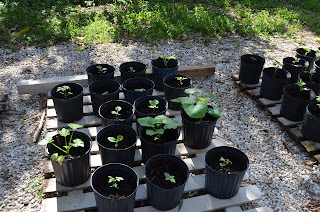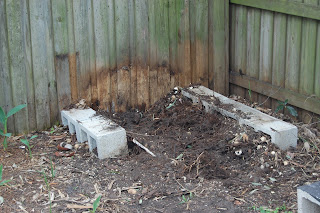What a busy week with the sprouts. So much growth in so little time. But before that, an explanation.
This desert rose sprout is the ultimate cause of this little experiment. Six weeks ago a friend gave me some seeds, which I decided to plant, which sprouted into this tiny little beauty. But the desert rose is a slow growing plant. One and half inches tall after six weeks. It may never get taller than two feet. I realized that a few more seeds and pots and I could have a backyard garden this summer (or so I hope). And so the experiment...
Two concerns in summer Florida.
1. The sun itself is scorching. Over the next eight to ten weeks, too much direct sunlight will burn the plants (although I'm hypothesizing that they will need some direct sunlight)
2. The heat, and especially soil that gets too hot, will prevent root growth and even kill plants. Having everything in black pots is of course a HUGE problem in this regard. This week I started bigger plans for plants and started the process of moving sprouts from the started pots to their final homes.
I brought a shelf that has held stuff on our front porch into the back and will place four plants atop that. In this photo I have tomatoes. These are the five transplants from Lakewood, all of which are infested with some kind of leaf mite that doesn't kill them but also doesn't seem to leave them any energy to grow.
These are the same sprouts pictured last week. You can see that the squash and beans in particular have grown a great deal. The tomatoes, eggplants, and tomatillos have grown as well, but not nearly as much. Dill, cilantro, and peppers grow even slower. All of the squash, the cucumber, the beans, two of the tomatoes, and the tomatillo have been moved to larger pots, transplanted hopefully for the last time this summer.
The soil I am using comes mostly from our compost, which you can see picture here. For the past three years we have been turning our household food waste and the smaller pieces of our yard waste into soil, piling it together, watering it occasionally, and turning it infrequently. We got a lot of soil after all this time (although nothing in comparison to the volume of waste I remember dumping into the compost pile in that time). I was surprised when I dug into the soil the other day and found masses of roots...
But when I stepped back and looked up I realized that we had been feeding the neighbor's cabbage palm for the whole time. It's roots came up into the soils we built and, no doubt, stole some of our nutrients! Curse you neighbor's cabbage palm!
The transplant operation involved digging soil, washing out the roots, and then mixing is up as dry as possible in the wheel barrow. I layered some oak leaves on the bottom of the pots, dumped in six to eight hand trowels of dirt, pulled the sprouts from their started pots, gently pulled apart the roots, and gave each of them their own individual home.
Here you see the winter squash and cucumber. Eight plants in all, four per starter pot. The morning was delightfully cool and mild until about 9:30.
By the end of the day, about 1/3 of the started plants had been transplanted into individual 2.5 gallon pots. Some of them, I am afraid, may desire more root space, but we'll assess the plants as they grow and see if they need one more transplant.
The cucumbers, which I expect to cascade over the top of this shelf and eventually down to the gravel below.
I had jump started the project yesterday, transplanting eight squash plants. This morning I decided the pallets would be placed out here at the end of the backyard gravel driveway. Eight pots plus five tomatoes from Lakewood.
By the evening, 23 new individual plants. We have beans, squash, tomatoes, and tomatillos. This location gets morning sun and evening sun directly, and is shaded through the hottest part of the day. We'll monitor progress and see how it works.
Many more transplants to go, but the most crowded plants are now ready to make roots and start growing us some edible fruit.
Direct questions to
The Gardener.































